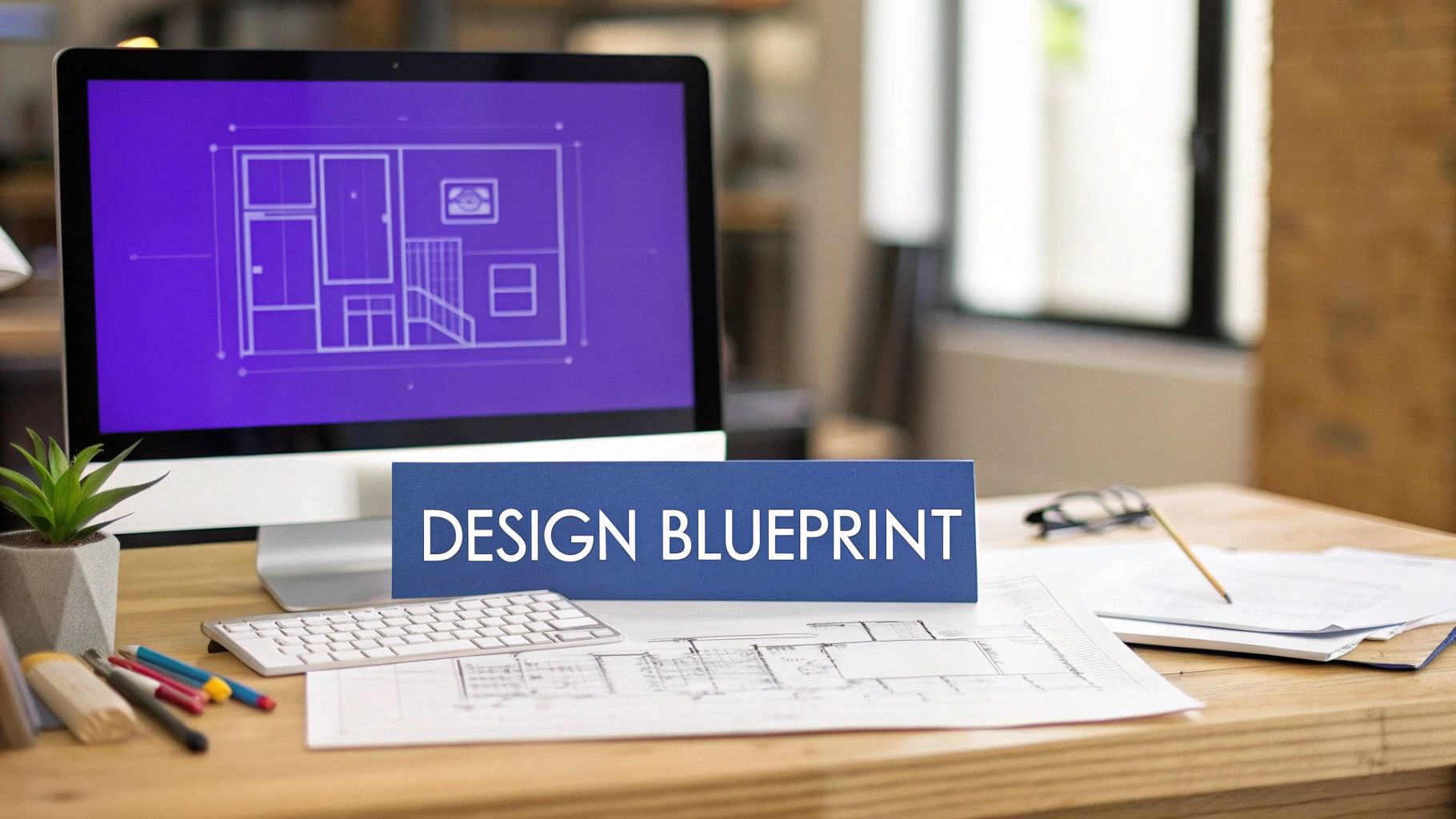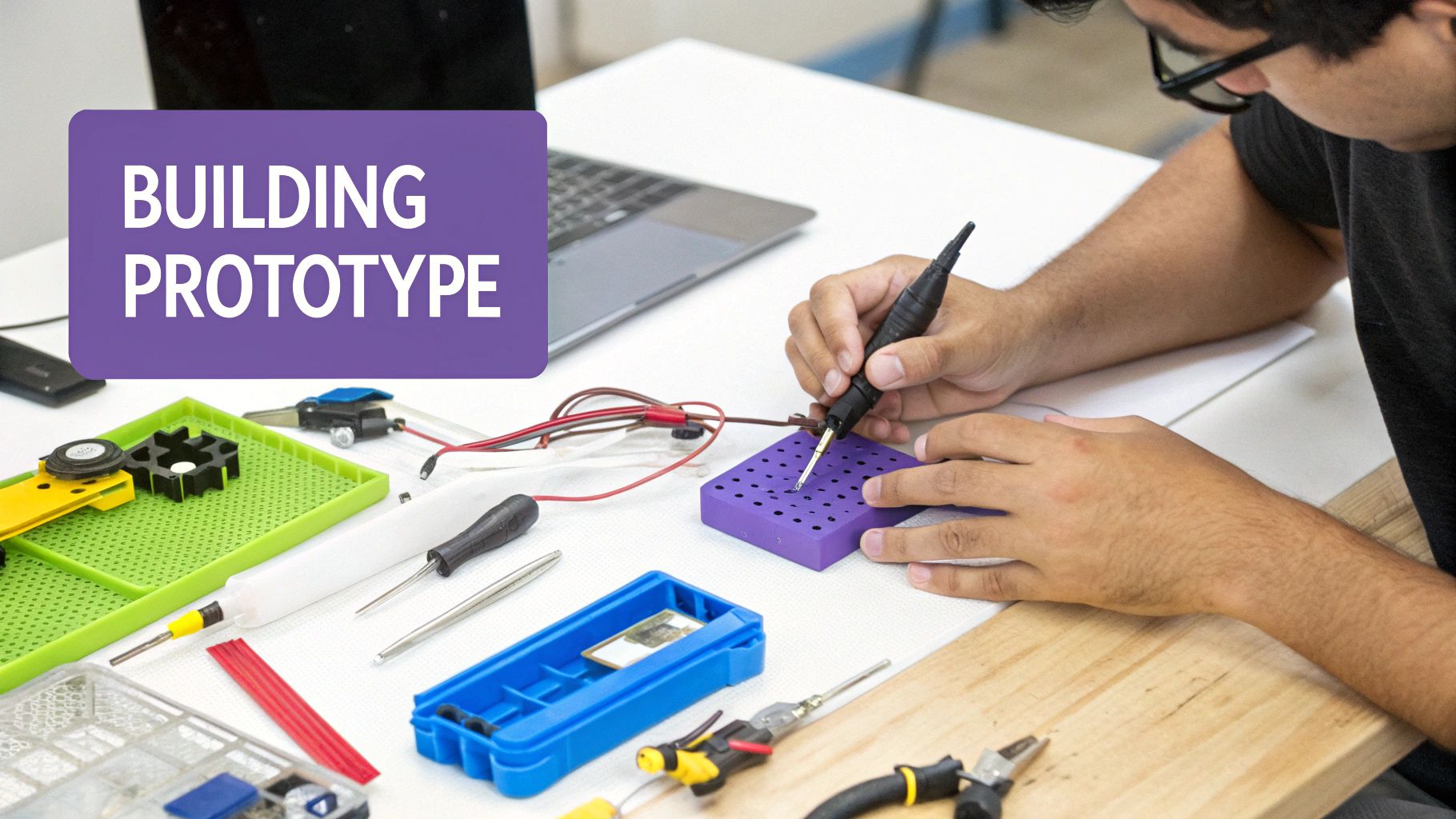The Evolution of Turning Ideas Into Reality

Turning ideas into reality has always been a fundamental human drive. For centuries, innovators have shaped our world by bringing their concepts to life. But the process of innovation has changed dramatically over time, influenced by technology, design principles, and the evolving needs of society. The tools and methods available to today's innovators are vastly different from those of the past.
From Industrial Revolution to Modern Design
The Industrial Revolution was a key turning point. Starting in the late 18th century, innovations like the steam engine and mechanized textile production transformed industries. This era established the groundwork for modern manufacturing and fueled further advancements. By the 20th century, design became a recognized profession, with figures like Henry Dreyfuss and Dieter Rams influencing modern product design. The Bauhaus movement, emphasizing the connection between form and function, further cemented the importance of design in bringing ideas to life. The Bauhaus school in Germany created over 1,500 designs in the 1920s, demonstrating the potential for artistic concepts to become real-world products. By the year 2000, the impact of these advancements was clear in established companies like Benefit-Mall.com. Learn more about this evolution in product development here.
The Rise of Rapid Prototyping and Digital Tools
The late 20th and early 21st centuries saw the emergence of rapid prototyping and digital tools. These technologies significantly sped up the process of turning ideas into reality. Computer-Aided Design (CAD) software allows designers to create detailed 3D models, and 3D printing enables the quick creation of physical prototypes. This has dramatically reduced the time and cost involved in product development. What once took months or even years to prototype can now be done in days, allowing for faster experimentation and iteration.
The Power of Collaboration and Open Innovation
The internet and collaborative platforms have created a culture of open innovation. Ideas are no longer limited to a single company or institution. Individuals and organizations can connect and work together on projects, sharing knowledge and resources. Crowdsourcing platforms and online communities offer valuable opportunities for feedback and refinement. Explore different ideation techniques in our guide here. This collaborative approach has led to groundbreaking products and solutions that wouldn't have been possible otherwise. This environment is especially valuable for remote teams, allowing for efficient connection and brainstorming. The ability to quickly share and refine ideas virtually has become a major driver of innovation.
The evolution of turning ideas into reality is an ongoing journey, constantly being shaped by new technologies and methods. But the fundamental principles of creativity, problem-solving, and perseverance remain crucial for anyone wanting to bring their vision to life. As we continue to push the boundaries of what's possible, the path from concept to creation will undoubtedly become even more dynamic and exciting.
Breaking Through Implementation Barriers
Turning an idea into a real, working project isn't easy. It's a journey filled with obstacles, and you'll need resilience, adaptability, and a good strategy to succeed. This section explores common roadblocks that can stop even the best ideas and offers proven strategies to get past them. We'll look at the experience of successful innovators who've managed to navigate these tricky implementation issues, giving you practical advice to help you bring your vision to life.
Understanding the Hurdles
There are several key barriers that often get in the way of making an idea a reality. One common issue is analysis paralysis. This happens when you overthink and over-plan, leading to a standstill. It can come from a fear of failure or a desire to make everything perfect, but it ultimately stops you from moving forward.
Another significant hurdle is resource constraints. This could be limited funding, a lack of specific expertise, or simply not enough time. Many promising ideas never get off the ground because of a lack of these crucial resources.
Keeping the ball rolling can also be a major challenge. The initial energy and excitement around a new idea can fade as the implementation process gets longer and more complex. Unexpected roadblocks and setbacks can add to the frustration, making it hard to stay focused and see the project through.
External resistance can also slow down progress. This can be skepticism from co-workers, pushback from stakeholders, or difficulty getting potential investors on board.
To illustrate, consider the tech industry. Only around 3% of startups achieve significant success. Those that succeed in transforming ideas into reality see substantial growth. Companies like Airbnb and Uber started with simple ideas but grew into global businesses through well-executed strategies. A 2020 case study found that successful startups invested an average of $100,000 to $500,000 in early-stage development to make their ideas a reality. The journey typically involves vetting the idea, thorough research, planning, execution, adaptation, and business growth. You can explore this topic further here.
Let's explore some common barriers and strategies to overcome them in more detail. The following table outlines some of these challenges:
Common Barriers to Implementation: A comparison of major obstacles to turning ideas into reality and effective strategies to overcome them.
| Barrier | Impact | Overcoming Strategy | Success Example |
|---|---|---|---|
| Analysis Paralysis | Inaction, missed deadlines | Prioritize action, Minimum Viable Product (MVP) | Launching a basic app version, gathering user feedback, and iterating. |
| Resource Constraints | Limited progress, stalled projects | Bootstrapping, strategic partnerships, prioritizing tasks | Seeking out collaborators or using open-source software. |
| Loss of Momentum | Decreased enthusiasm, project abandonment | Setting milestones, celebrating small wins, regular communication | Breaking down a large project into smaller, manageable tasks. |
| External Resistance | Lack of support, difficulty securing funding | Building consensus, addressing concerns, demonstrating value | Presenting a compelling business case to stakeholders. |
This table highlights how understanding the potential challenges allows for proactive strategies and improves the likelihood of successful implementation.
Practical Strategies for Overcoming Barriers
How do successful innovators overcome these implementation barriers? They create and use clear strategies. To fight analysis paralysis, they prioritize action over perfection. This means taking small, manageable steps rather than getting stuck in lengthy planning. They adopt the Minimum Viable Product (MVP) approach, focusing on launching a basic version of their idea quickly and improving it based on user feedback.
When facing resource constraints, they get creative. They explore bootstrapping methods, build strategic partnerships, and network to access needed expertise and support. They learn to prioritize and focus their energy on the most important activities, getting the most out of their limited resources.
Building a Framework for Success
A solid framework is key for navigating the challenges of bringing ideas to life. This framework should cover risk assessment, decision-making under pressure, and how to stay focused despite resistance. By thinking ahead about potential problems and developing backup plans, you can reduce disruptions and keep moving forward. To maintain momentum, they set smaller milestones and celebrate achieving them. This helps keep motivation high and gives a sense of accomplishment, especially during tough times. They also keep communication lines open, regularly updating everyone involved on the progress made. This promotes transparency and helps to build support.
By understanding and addressing these implementation barriers, you greatly improve your chances of turning your ideas into something real. The path may be challenging, but with the right approach and a positive mindset, you can overcome the obstacles and achieve your goals.
The Proven Pathway: From Concept to Completion

Turning ideas into reality takes more than just a creative spark. It requires a structured process. This section provides a practical, step-by-step method for transforming those initial sparks into tangible results. We'll explore proven frameworks used by successful individuals and organizations, offering actionable steps you can use right away. This pathway minimizes wasted effort and maximizes your chances of success.
Phase 1: Idea Validation
This initial phase is critical. It ensures you’re investing your time and resources wisely. Idea validation means thoroughly vetting your concept to determine its feasibility and potential.
-
Market Research: Begin by understanding the current market. Are there similar products or services available? What are their strengths and weaknesses? Knowing your target audience and understanding their needs is crucial.
-
Problem-Solution Fit: Clearly define the problem your idea solves. Does it address a real need? Is the solution practical and effective? A strong problem-solution fit is the foundation of successful implementation.
-
Competitive Analysis: How does your idea compare to the competition? What unique value does it offer? Understanding your competitive advantage is essential for long-term success.
For example, imagine a new type of reusable water bottle. Market research would involve analyzing the existing water bottle market and understanding consumer preferences. Problem-solution fit would focus on the specific problem your bottle solves. Perhaps it's better insulated or easier to clean. Competitive analysis would involve comparing your bottle to existing options and highlighting its unique features. This validation process sets the stage for success.
Phase 2: Resource Allocation
Once your idea is validated, gather the necessary resources. This includes funding, expertise, time, and the right tools.
-
Financial Planning: Determine the financial resources required. Develop a budget and explore potential funding options.
-
Team Building: Identify the skills and expertise needed for your project. Assemble a team that complements your strengths and fills any gaps. Even solo projects benefit from advisors or mentors.
-
Tool Selection: Choose the right tools and technologies. This might include project management software or communication platforms like Bulby, designed to enhance brainstorming for remote teams.
Phase 3: Execution and Tracking
This is where you turn ideas into reality. A structured approach is essential.
-
Project Planning: Break down your project into smaller, manageable tasks. Create a timeline with milestones and deadlines. This roadmap will guide your progress.
-
Progress Monitoring: Regularly track your progress against your plan. Identify roadblocks early and take corrective action.
-
Communication: Maintain open communication with your team and stakeholders. Share updates, address concerns, and ensure everyone is aligned.
For example, developing a mobile app might involve phases like design, development, testing, and launch. Tracking progress against these phases helps identify potential delays.
Phase 4: Iteration and Refinement
Turning ideas into reality is iterative. The initial concept rarely stays the same.
-
Feedback Collection: Gather feedback from users and stakeholders. This input helps identify areas for improvement.
-
Adaptation: Be prepared to adjust your approach based on feedback and changing circumstances. Flexibility is key.
-
Continuous Improvement: Embrace a mindset of continuous improvement. Regularly evaluate your progress and identify opportunities to enhance your product or service.
This continuous cycle ensures your final product meets the needs of your target audience. You might be interested in: How to master the innovation process.
This structured pathway empowers you to turn ideas into reality effectively. By focusing on validation, resource allocation, execution, and iteration, you can navigate challenges and increase your chances of success. Remember, persistence and adaptability are key. The journey from idea to reality is often a marathon, not a sprint, requiring vision and dedication.
Developing Your Implementation Mindset
Turning ideas into reality isn't simply about brainstorming a great concept. It's also about cultivating the right mindset to see it through. This involves building a strong psychological foundation, a combination of cognitive patterns and emotional resilience that separates those who consistently implement ideas from those who struggle. Let's explore the mental strategies and techniques needed for successful execution.
Cultivating Mental Toughness
Mental toughness is essential for navigating the inevitable challenges that arise during implementation. This involves cultivating perseverance, a willingness to push through obstacles even when progress feels slow or difficult. It’s similar to training for a marathon – you wouldn’t expect to run 26.2 miles on your first attempt. Similarly, transforming complex ideas into reality requires consistent effort and a commitment to persevere despite setbacks.
Consider the experience of software engineer interns at Optiver, a high-frequency trading firm. These interns work on projects expected to reach production within a single summer. This demanding timeframe requires significant focus and resilience. One intern, tasked with improving data pipeline efficiency, had to navigate multiple layers of existing systems and quickly learn how data was handled throughout the firm. This example highlights the real-world pressure and challenges of implementation, emphasizing the importance of a determined "stick-with-it" attitude.
Maintaining momentum during extended projects is also crucial. Breaking down larger goals into smaller, more manageable steps can significantly help. Celebrating small wins along the way reinforces the positive cycle of effort and progress, helping to maintain enthusiasm. Just like a marathon runner focuses on the next mile marker, concentrating on achievable milestones keeps motivation high and prevents feeling overwhelmed by the project's scope.
Embracing Flexibility and Adaptability
While persistence is essential, adaptability is equally important. Implementing ideas often requires adjusting your approach based on feedback and changing circumstances. This means being willing to deviate from the initial plan when necessary. An FPGA intern at Optiver, tasked with optimizing communication between software and FPGAs, experienced this firsthand. The intern's initial research and collaboration with hardware and software teams ultimately led to a redesigned communication interface. This demonstrates the importance of remaining open to new solutions and adapting as needed.
Accept that your initial concept may evolve throughout the implementation process. Being receptive to feedback, whether from colleagues, users, or mentors, is essential for improvement. This feedback provides valuable insights and often leads to a stronger end product. Like a writer revising a manuscript based on editorial feedback, being open to constructive criticism strengthens the entire implementation process.
Overcoming Perfectionism and Fear of Failure
Perfectionism can be a significant internal roadblock to implementation. The desire to create something flawless can lead to analysis paralysis, preventing any action at all. Recognize that perfection is often unattainable. Prioritizing progress over perfection means focusing on taking small, consistent steps forward, even if they’re not perfect. As successful solopreneur Justin Welch advises, “Get started. That's how you’ll figure out your own journey.” This emphasizes the importance of action over endless planning or aiming for an unrealistic ideal.
Another major hurdle is the fear of failure. This fear can be paralyzing, preventing us from taking necessary risks. It’s crucial to reframe failure as a learning opportunity. Every setback provides valuable insights that can inform future attempts. Developing emotional resilience helps you bounce back from setbacks and view them as stepping stones on the path to success.
Building Your Implementation Muscles
Like physical muscles, the psychological traits that support implementation can be strengthened through practice. Regularly setting implementation goals, breaking them down into manageable steps, and tracking progress can build these mental "muscles." Reflecting on past experiences, both successes and failures, offers valuable lessons and increases self-awareness. By consistently applying these principles, you can develop the implementation mindset needed to bring your ideas to fruition.
Leveraging Technology and Innovation Systems

Turning ideas into reality is a journey. It starts with a spark of inspiration and ends with a tangible product or service. This process demands efficient systems, the right tools, and effective processes. This section explores how technology and well-designed innovation systems can accelerate this journey. We'll see how successful organizations build systems that consistently deliver results.
The Power of Digital Platforms
Digital platforms offer a wealth of resources to help bring ideas to life. Project management software helps streamline workflows, track progress, and improve communication. Platforms like Bulby offer structured brainstorming and AI-powered guidance, especially helpful for remote teams. These tools break down projects into smaller tasks, allocate resources, and provide a central hub for everyone involved. This boosts efficiency and reduces miscommunication.
Streamlining Workflows with Project Management Methodologies
Effective project management methodologies are crucial for moving from concept to completion. Agile methodologies focus on iterative development, frequent feedback, and adaptability. This lets teams respond quickly to changes and refine ideas in real-time. Other frameworks like Lean Startup concentrate on building a Minimum Viable Product (MVP) quickly and testing it in the market. These approaches empower teams to be flexible and learn throughout the process.
Building Repeatable Systems for Consistent Results
Innovative organizations build repeatable systems that consistently turn ideas into tangible outcomes. This involves clear processes for idea management, resource allocation, and progress tracking. A well-defined system vets and prioritizes ideas effectively. Tracking mechanisms monitor progress and allow for adjustments. Organizations with a structured process for evaluating ideas are more likely to identify high-potential concepts. This strategic approach maximizes resource allocation and increases the overall success rate.
Let's look at a comparison of a few innovation systems and their effectiveness:
Innovation Systems Comparison
| Innovation System | Best For | Implementation Time | Success Rate | Notable Examples |
|---|---|---|---|---|
| Stage-Gate Process | Large organizations with complex projects | Long (several months to years) | Moderate (depends on stage gate criteria) | New product development in manufacturing |
| Lean Startup | Startups and new ventures | Short (weeks to months) | High (focus on rapid iteration and learning) | Tech startups, mobile apps |
| Design Thinking | Human-centered problem solving | Moderate (weeks to months) | High (user-focused approach) | Service design, product design |
| Crowdsourcing | Gathering diverse perspectives | Short (days to weeks) | Varies (depends on quality of input and evaluation process) | NASA, Google |
This table highlights the varying strengths and weaknesses of different innovation systems, suggesting that the "best" system depends heavily on the context. For instance, while Lean Startup prioritizes speed and iteration, the Stage-Gate process provides a more structured approach suitable for complex projects. Crowdsourcing, on the other hand, offers a way to tap into diverse perspectives and generate a large volume of ideas.
Many organizations recognize the importance of systematic innovation. Companies fostering a culture of innovation saw a 25% increase in revenue by 2023. Effective innovation pipelines can reduce new product failure rates by up to 30%. Companies like NASA and Google use crowdsourced innovation, generating thousands of ideas annually. This shows how turning ideas into reality systematically can lead to significant success. Learn more about this transformation here.
Selecting the Right Tools for Your Needs
Choosing the right tools is essential. This depends on your challenges and the nature of your projects. You might find this article helpful: How to master creativity in problem-solving. While some projects benefit from sophisticated software, others may only require simpler tools. The key is to select technologies that enhance your workflow without adding unnecessary complexity. Think about how software engineers and FPGA developers choose tools based on project requirements, balancing advanced capabilities with efficiency.
Integrating Tools into Efficient Workflows
Integrating tools into workflows streamlines the process from idea to execution. This means connecting different platforms and ensuring smooth data flow. This removes manual steps, reduces errors, and allows for better tracking and analysis. Think of it like an assembly line – each tool has a specific role in moving the product towards completion. Similarly, integrated technologies help accelerate the journey from idea to reality.
Leveraging technology and establishing well-defined innovation systems can significantly improve your ability to turn ideas into reality. These tools and systems are not just about efficiency, but also about fostering a culture of innovation and maximizing your chances of success.
Success Stories: Ideas Transformed Into Reality
Turning ideas into reality can be tough, but the payoff is huge. This section explores real-world examples of how people and companies have successfully made that leap, offering practical insights for your own projects. These stories are inspiring and show how the principles we've discussed actually work.
From Intern to Innovator: Real-World Impact at Optiver
The high-frequency trading firm Optiver shows how interns can turn ideas into real-world solutions. Their summer internship program gives interns real business problems to solve and expects them to develop and implement solutions within a single summer. This fast-paced setting encourages innovation and provides valuable experience in bringing ideas to life.
-
Sabrina's Story: Sabrina, a software engineering intern from MIT, took on the challenge of improving data pipeline efficiency. Data streams were slowing down due to increased exchange interactions. To solve this, Sabrina created a custom binary file format. This new format dramatically sped things up and made the system more scalable for Optiver's growing data volume. Her project wasn't just about coding; it also involved understanding the impact of the changes on other systems and teams.
-
Varun's FPGA Solution: Varun, an FPGA intern from Carnegie Mellon, focused on optimizing communication between software and FPGAs. He redesigned the communication interface, significantly reducing the time software spent waiting to send data. This also freed up valuable FPGA resources. This optimization directly addressed a critical bottleneck in Optiver's systems and demonstrated the impact of a well-executed idea.
These examples show the importance of ownership, collaboration, and practical solutions. They demonstrate how even interns, with the right support and environment, can make big contributions. Both Sabrina and Varun took ownership of their projects, showing how empowering people can lead to significant breakthroughs. Their experience highlights the value of a supportive structure that also allows for individual creativity.
Solopreneurs: Building From Scratch
Being an entrepreneur often means working solo, requiring a unique blend of creativity and resilience. Justin Welch, a successful solopreneur, stresses the importance of just getting started. "Get started. That's how you’ll figure out your own journey," he advises. This highlights how ideas evolve. The initial concept often changes significantly, and the best learning comes from taking action.
Welch emphasizes the value of writing to clarify thoughts and make progress. He recommends a "brain dump" to get all your initial ideas down, followed by organizing and structuring those thoughts. This process of writing, refining, and iterating is key to turning vague concepts into concrete plans.
Networking is another critical aspect. Welch recommends joining online and offline groups, listening actively, and contributing positively. This builds connections and opens doors to mentorship, collaboration, and partnerships.
From Concept to Book: Andy Strote's Agency Journey
Andy Strote, founder of two creative agencies, reinforces these concepts. He emphasizes writing as a tool for idea development. "Writing forces you to think and make progress," he states. This echoes Welch's advice, highlighting how writing helps refine thoughts.
Strote stresses the iterative nature of the process, emphasizing drafts and revisions. He encourages embracing imperfection and focusing on continuous improvement. "Don’t be concerned about perfection," he states. "It’s just information in a document. You can always edit more later." This perspective allows for experimentation and learning without the pressure of perfection.
These diverse examples, from individual entrepreneurs to global enterprises, highlight the universal principles of turning ideas into reality. The specific challenges and resources may differ, but the core elements remain constant: a clear vision, structured execution, adaptability, and perseverance. By learning from these stories, you can improve your chances of turning your own ideas into real achievements. The journey from concept to completion is a process, and these examples provide a helpful guide.
Your Action Plan for Turning Ideas Into Reality

This section offers a personalized roadmap to help you successfully bring your ideas to life. We'll explore a flexible framework that can be adapted to your unique idea, available resources, and specific situation. We'll also discuss the key factors that contribute to successful implementation, common obstacles you might face, and practical ways to measure your progress. This will equip you with tangible next steps and effective strategies to begin putting your ideas into action.
Assessing Your Implementation Strengths and Weaknesses
Before diving into action, it's important to understand your strengths and weaknesses when it comes to implementation. A self-assessment can be invaluable in highlighting areas for potential growth. For example, do you tend to overanalyze, leading to analysis paralysis? Or perhaps you find resource management challenging. Pinpointing these areas allows you to develop targeted strategies for improvement.
Honest self-reflection is the first step. Think back to past projects. What aspects were successful? Where did you encounter roadblocks? This type of retrospective analysis can reveal recurring patterns and inform your approach to future endeavors. For instance, if you consistently find it difficult to maintain momentum, you might consider setting smaller, more achievable milestones and celebrating small victories along the way. A software engineer proficient in code optimization might recognize a weakness in system integration. This awareness allows for proactive planning and seeking the necessary support.
Critical Success Factors for Turning Ideas Into Reality
Several key factors contribute to successfully transforming an idea into a tangible outcome. A clear vision is paramount. This involves a well-defined concept and a solid understanding of the problem you aim to solve. This could range from improving communication between software and hardware components to designing a new file format for efficient data processing.
A well-defined plan is equally crucial for smooth execution. Breaking down your project into manageable phases, as discussed earlier, facilitates better organization and progress tracking. This structured approach can help prevent feeling overwhelmed. This could involve distinct phases like market research, product development, testing, and launch, mirroring the strategies employed by successful startups.
Effective communication is also essential, particularly when collaborating with a team. Maintaining open communication channels minimizes misunderstandings and fosters a collaborative environment. Regularly updating stakeholders and incorporating their feedback strengthens project buy-in and ultimately improves outcomes.
Avoiding Common Pitfalls
While understanding critical success factors is essential, being aware of potential pitfalls is equally important for preventing missteps. Lack of focus is a common challenge. Getting sidetracked by new, seemingly exciting ideas or neglecting thorough research can lead to wasted time and resources.
Another frequent pitfall is underestimating the resources required. Accurate budgeting and anticipating potential delays are crucial for a smooth implementation process. Properly accounting for necessary support, both in terms of personnel and resources, can prevent setbacks and ensure project completion.
Failing to adapt to changing circumstances is another significant obstacle. Feedback often reveals necessary adjustments to the initial plan. A willingness to adapt and refine your approach based on new information and evolving circumstances is crucial for success.
Measuring Your Progress
Using clear metrics is essential for effectively tracking your progress. These metrics should align directly with your overall goals and the specific nature of your project. For example, if your goal is to enhance data pipeline efficiency, relevant metrics might include processing speed or data transfer rates. Regularly monitoring these metrics provides valuable insights into your progress and allows for timely adjustments if needed.
Taking the Next Step: Turning Your Ideas Into Action
Now that you've explored the key elements of bringing ideas to fruition, it's time to take the next step. Begin by identifying your most promising idea. Conduct thorough research, develop a comprehensive plan, and break down your project into smaller, manageable tasks. Gather the necessary resources and begin the implementation process. Remember to track your progress, adapt your approach as needed, and celebrate the small wins along the way.
For remote teams seeking to improve their brainstorming and idea generation process, consider using Bulby. Bulby is a brainstorming platform specifically designed for remote teams, offering structured exercises and AI-powered guidance to transform ideas into actionable insights. Learn more about Bulby and discover how it can empower your remote team to reach its full creative potential.

